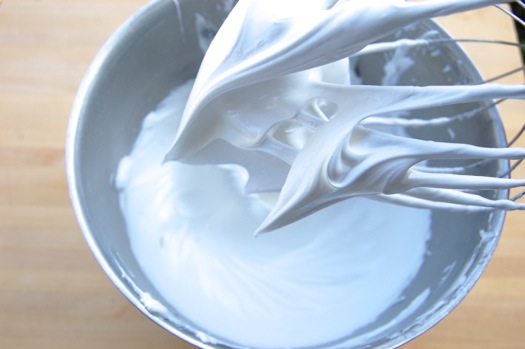There Are Meringues, and Then There Are Meringues

The world of meringues is a wide one. Broadly speaking it’s divided into two categories: cooked meringues and uncooked meringues. However within those two groups there’s a lot of variation. Meringues can be mildly sweet or intensely sweet. They can be light and frothy or dense and marshmallow-y. They can be baked to crispness, browned in the oven (or with a blowtorch) or eaten as they are.
An American pie meringue is an uncooked, medium-sweet, light and frothy meringue that is also gently baked. This makes it a different animal compared to the denser, creamier cooked meringues that typically adorn European-style lemon tarts, even though the presentation looks very similar. American pie meringue is a sweet froth that makes a lovely counterpoint to a dense citrus curd, as it heightens the fresh feeling you get when you put a bit of both in your mouth.
A common question in regard to American pie meringue is: if the idea is freshness and lightness, why does it need to be baked at all? The answer is that unlike denser, more sugar-intensive meringues, American pie meringue it will lose volume and weep moisture if the egg proteins in it aren’t coagulated just a little bit. The bubbles inside it are large and not heavily reinforced with sugar syrup. It takes a little lightly cooked (slightly clumped up) egg protein to shore them up. Take that idea too far of course and those same proteins clench too tightly, squeeze out moisture and, well, see below.
Still it’s all worth it to my mind, since there’s nothing better as a closer to summer meal than the delicate texture of a good meringue pie.
I have a sad meringue story (insert weeping pun here). Last week, a blog convinced me that I could make a meringue with maple syrup without cooking the syrup or eggs prior to baking. The post contradicted many things that you have posted but the pictures of maple-y meringues called out to me. I can’t say no to maple desserts.
I had fairly low expectations because I was using the sad little whisk attachment for the immersion blender I use during Passover. After much cajoling, I got my egg whites primed for a pinch of salt and cream of tartar. With a delicateness that surprised me, I slooooooowly drizzled in the maple syrup. It was downhill from there. Not only did the egg white refuse to form even the slightest peaks, they devolved into a sad, flat puddle at the bottom of my bowl and the blender body got so hot, I couldn’t touch it. I probably would have gotten a better result shaking them around in a mason jar.
I learned two valuable lessons:
1) A total stranger’s pretty pictures should not persuade me to go against the knowledge and experience you so graciously share with us.
2) Next year, I will buy whisk and beater stand mixer attachments for Passover use.
Weeping indeed!
Very interesting Alex! I can imagine such a process working with a very thick maple syrup. The trouble is that some maple syrups can be quite watery indeed — up to 40% water — and that’s enough to dilute the egg white and undermine it’s ability to foam (as you discovered). If you’re passionate about maple I wouldn’t completely give up on the process, just find yourself some seriously thick syrup!
Cheers and thanks for a very interesting comment!
– Joe
I wonder if maple sugar would work instead of maple syrup? It’s expensive, but I’ve seen it for sale on Amazon.
Nice thinking Jeannine! I think that would work, yes indeed.
– Joe
Or …dun, dun, dun…Maple Extract/Flavor.
I wasn’t going to say it — I’m glad somebody did! Thanks, Derek!
– Joe
Jumping in to say, Nigella suggests maple sugar for meringues in How to Eat: “maple sugar for the most fabulous, smoky, gleaming, elegant meringue of all time, the color of expensive oyster-satin.” I haven’t tried it, but she makes it sound lovely!
Lovely indeed, Sharon! Thank you!
– Joe
The mouth-feel is the VERY reason I can’t stand American meringue on pies. I would prefer one with a smoother or silkier texture. Not to the level of marshmallow but not so frothy.
Fair enough. To each their own I say. To me it’s just the right amount of sweetness and body.
Thanks, Linda!
– Joe
This is awesome! I’m a huge fan of meringues, both for eating and for their science, which is really cool. My favorite part is how you can make such different textures with really subtle changes–thanks for mentioning that!
I actually just wrote a short series of posts about the science of meringues on my blog. I hope you get a chance to check it out: http://fchem101.com/2014/02/17/chocolate-hazelnut-meringues/
Great stuff, Janelle! Nice to meet a kindred spirit on the blogosphere! I shall be stopping in often!
Cheers,
– Joe